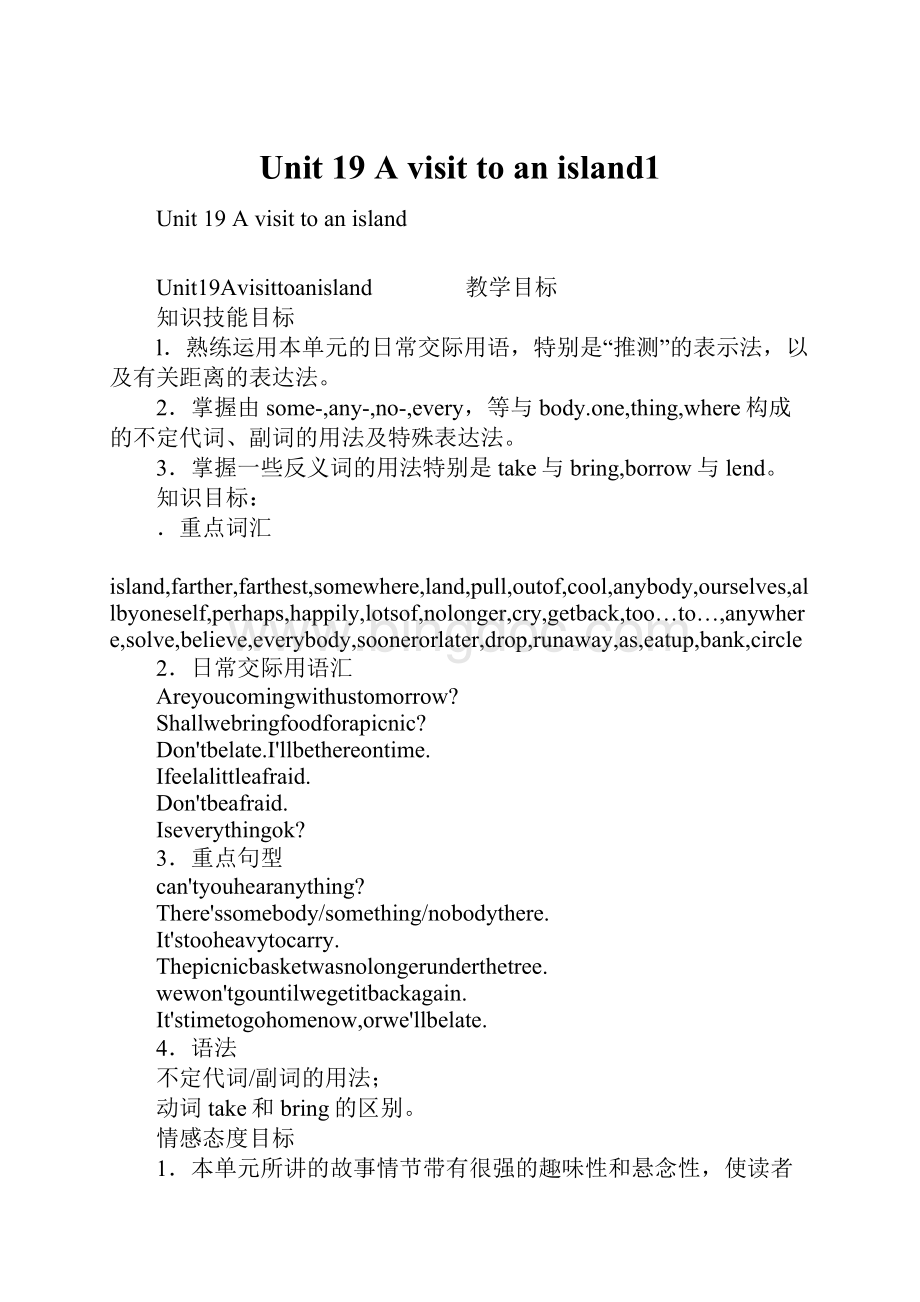Unit 19 A visit to an island1.docx
《Unit 19 A visit to an island1.docx》由会员分享,可在线阅读,更多相关《Unit 19 A visit to an island1.docx(11页珍藏版)》请在冰点文库上搜索。

Unit19Avisittoanisland1
Unit19Avisittoanisland
Unit19Avisittoanisland 教学目标
知识技能目标
l.熟练运用本单元的日常交际用语,特别是“推测”的表示法,以及有关距离的表达法。
2.掌握由some-,any-,no-,every,等与body.one,thing,where构成的不定代词、副词的用法及特殊表达法。
3.掌握一些反义词的用法特别是take与bring,borrow与lend。
知识目标:
.重点词汇
island,farther,farthest,somewhere,land,pull,outof,cool,anybody,ourselves,allbyoneself,perhaps,happily,lotsof,nolonger,cry,getback,too…to…,anywhere,solve,believe,everybody,soonerorlater,drop,runaway,as,eatup,bank,circle
2.日常交际用语汇
Areyoucomingwithustomorrow?
Shallwebringfoodforapicnic?
Don'tbelate.I'llbethereontime.
Ifeelalittleafraid.
Don'tbeafraid.
Iseverythingok?
3.重点句型
can'tyouhearanything?
There'ssomebody/something/nobodythere.
It'stooheavytocarry.
Thepicnicbasketwasnolongerunderthetree.
wewon'tgountilwegetitbackagain.
It'stimetogohomenow,orwe'llbelate.
4.语法
不定代词/副词的用法;
动词take和bring的区别。
情感态度目标
1.本单元所讲的故事情节带有很强的趣味性和悬念性,使读者的心态随着孩子们的心态变化而变化,扣人心弦,从而领会到情节安排的巧妙。
2.通过对孩子们参观小岛过程的描述,可使我们欣赏到奇特的小岛风光。
通过本单元教学培养学生独立生活的能力。
遇事要沉着冷静、胆大心细、善于思考。
教学建议
教学内容分析
本单元的教学核心是关于孩子们参观小岛(Avisittoanisland)的这件事。
围绕这个核心安排了三个对话和两篇短文,集中反映了孩子们上岛前所做的准备工作(约会、带食品、约定出发的时间,讨论去哪一个岛等)及在岛上的所见所闻,情节跌宕起伏,有一定的传奇色彩。
在整个内容的安排中引出了本单元要学习的功能项目“推测”(conjecture)、求助(callingforhelp)和动词take,bring的区别及不定代词和不定副词的用法。
在第73课中有两段对话,主要描述孩子们在上岛前所做的准备工作及讨论去哪一个岛。
从而引出英语中表示距离远近的表达法。
如:
whydon’twegotothefartherone?
/Howaboutthefarthestone?
/Thesmalleroneisnears.这两段对话为下节课做了内容上的铺垫。
第74课和第75课的第一部分及第76课的第一部分事实上是一个故事的整体,具体描绘了孩子们在岛上的所见所闻,表现了孩子们新奇、紧张、害怕交叉在一起的复杂心情。
第76课中关于一群猴子企图偷吃篮子里食物的一段描写颇为生动。
第75课的第二、三部分着重练习不定代词和不定副词的用法。
第76课的第四部分是提示性的写作训练。
主要是对课文的模仿和对所学内容的实际运用。
教师可以作一些适当的解释。
第五部分是一首小诗。
重难点及疑点分析
重难点:
1.nolonger=notanylonger,notanymore.nolonger与系动词be连用时置于系动词be的后面,与行为动词连用时放在行为动词的前面,如:
1)Heisnolongeraworker.=Heisn'taworkeranylonger/anymore.He’sanengineernow.
2)Henolongerliveshere.=Hedoesn'tlivehereanylonger/anymore.He’slivinginanothercity.
2.There’ssomethingwrongwithyourears.
There+be+something/nothingwrongwith...是一个固定的句型,意思是“…出/没毛病(问题)。
它的同义句是Something/Nothing+bewrongwith...如:
1)Thereissomethingwrongwithyourcomputer.=Somethingiswrongwithyourcomputer.It’snotworkingnow.
2)Thereisnothingwrongwiththenewbike.=Nothingiswrongwiththenewbike.It’squiteok.
疑点:
1.短语too…to
too…to句型的意思是“太……以致不能……”,too是副词,后面接形容词或副词,to是动词不定式的标志,后接动词原形。
该句型虽然没有否定词not或no,但具有否定的意义。
若需要加上人称,则在不定式之前加forsb。
如:
1)Thesentenceistoodifficulttounderstand.Pleasegivemeaneasyone.
2)Theseapplesaretoohighforustoreach.we’dbettergetaladder.
2.we'dbetternotgothere.It’stoofarfromhere.
hadbetter后面接动词原形,其否定形式是hadbetterno+动词原形。
had不受人称限制,不可以说have/hasbetter。
如:
Girlshadbetternotgooutatnight.Theyhadbetterstayathome.
2.we’veneverbeentherebefore.
该句型have;hasbeento+地点名词表示某人曾去过某地,现在已离开那个地方或已回来。
若地点是副词则“to”省略。
如:
wehaveneverbeentoShanghai.Buttheyhavebeenthereforthreetimes.TheycantellusalotaboutShanghai.
3.wewon'tgountilwegetitbackagain!
本句中的until作连词,引导一个时间状语从句。
not…until意为“直到……才”,“在……之前不……”,主句中的谓语动词一般是非延续性动词,如leave,finish,begin,go,start等,until引导的时间状语从句中将来时用一般现在时表示。
如:
Theywon'tleavetheirschooluntiltheirteacherreturns.Theywillasktheteachermanyquestionsuntiltheyareabletodotheseexercises.
口语训练
本单元的口语训练主要包括两项内容①表示距离远近的用法。
②不定代词和副词的用法。
1.表示距离远近的用法
在学生熟练掌握第73课第二部分内容的基础上,先回忆一下以前学生用书中所出现的一些有关距离的表示法。
如Howfarisit?
/Isitfar?
/It’s/quitenear./It’sabout…kilometersfarthest(furthest)等。
同时复习一下far这个词的不规则比较级形式和最高级形式。
far→farther(further)→farthest(furthest),告诉学生near(close)的比较级和最高级形式的变化是规则的。
老师可以给学生一些提示,让学生相互之间展开由易到难的练习。
(1)编制一些简单的问句问学生。
如:
Howfarisitfromyourhometoschool?
Isitnearfromyourhometoyouruncle’s?
IsourschoolfarfromPeoplePark?
where’stheshoppingcenter?
等。
(2)编制一段对话。
如:
Lucy:
Hi,LiLei!
whereareyougoingthissummerholiday?
LiLei:
myfatherwilltakemetoNanjing.
Lucy:
Howwonderful!
Nanjingisanoldbutbeautifulcity.Howfarisitfromhere?
LiLei:
It'sabout360kilometres.whataboutyou?
Lucy:
I’mgoingtoShanghaiwithmyuncletoseemygrandfather.Heworksthere.
LiLei:
Howfarisitfromhere?
IsitnearerorfartherthanNanjing?
Lucy:
It'snearer.It'sabout180metres.
A:
whichcitydoyoulikebest,Qingdao,NanjingorHangzhou?
B:
IlikeHangzhoubest.
A:
IsHangzhounearhere?
B:
No,It’sfarfromhere.It’sabout210kilometresaway.
A:
whataboutNanjing?
B:
It'sfarther.It’s600kilometresaway.
A:
AndQingdao?
B:
It’sthefarthest.It’snearly1000kilometresaway.
2.不定代词和副词的用法
在第74课及第75课中出现了不定代词和副词的用法。
在第75课中更为集中,首先对一些不定代词作一些归纳。
列表如下:
somebody
someone
something
somewhere
anybody
Anyone
anything
anywhere
nobody
noone
nothing
nowhere
然后告诉学生这些词都是由some,any或no与body,thing,one或where构成的合成词,一般情况下,somebody,something,somewhere用于肯定句,而anybody,anything,anywhere用于否定句、疑问句及条件句中。
如:
Icanseesomethingonthewall.Isitanewpainting?
Somebodyisknockingatthedoor.Goandhavealook.
yesterdayHanmeifoundherpensomewhere.Nowshestilldoesn’tknowwhoputitthere.
canyouhearanythinginthenextroom?
Somebodyiscrying.
(5)–Isthereanybodyrunningontheplayground?
–yes,it’swangTong.
Ican'tseeanybodyintheteacher'soffice.ButImustasktheteacheranimportantquestion.
Theydidn'tgoanywhere,becauseitwasrainingheavily.Theyplayedping-pongintheclassroom.
但也有例外情况。
当表达请求、建议、反对等肯定意图时,something,somebody等词也可用于疑问句形式。
如:
–Issomebodycomingthisevening?
–yes,ButIdon’tknowwho’scoming.
wouldyoupleasegivemesomethingtoeat?
certainly.Helpyourselftoanythingintheicebox.
教师可通过实物教学或创设情景教学,让学生在情景中学习并掌握不定代词或副词的运用。
如教师可利用教室中的物品:
box,bag等进行活动。
A:
canyouseeanythinginthebox?
B:
No,Ican’t.It’sclosed.
c:
Ithinkthereissomethinginit.
B:
Idon’tthinkso.Let’sopenit.maybethere’snothinginit.
还可以出示图片假设情景:
孩子们在春游,看见远处树丛中树叶晃动。
A:
Look!
canyouseeanythingoverthere?
B:
No,Ican’tseeanything.
A:
Nothing?
Lookcarefullyandyou’llseesomethinginthetrees.
B:
SorryIcan’t.Somethingiswrongwithmyeyes.
A:
There’snothingwrongwithyoureyes,Ithink.Lookagainandyou’llseeit.
B:
oh,yes.Somethingismovinginthetree.It’sayellowbird!
巩固性练习:
在学生了解不定代词基本用法的基础上指导学生做练习册第87页上的练习2,教师也可以适当补充一些课外练习来进一步加以巩固。
教学take和bring的用法
take和bring都有“拿”和“带”的意思。
学生在实际运用中容易混淆。
一般来说take是把东西拿到离开说话人所说话的地方。
表示“拿走”或“带走”。
而bring则表示把东西拿到说话人所说话的地方,是“拿来”,“带来”的意思。
用图表示:
教师可以设置一些具体的情景,让学生进行练习。
如:
A:
where’syourhomework,wangming?
B:
Sorry,Ileftitathome.
A:
Bringitheretomorrow.
B:
ok.
A:
Bytheway,whosechairisit?
B:
ourteacher's.
A:
Pleasehelpmetakeittotheteacher’soffice.
B:
Allright.
A:
Thanksalot.
B:
yourewelcome.
takesth.withsb.表示随身带走某物,bringsth.withsb.则表示随身带来某物。
takesth.away表示拿走某物。
试比较:
Itisgoingtorain,pleasetakeyourraincoatwithyou.
whenyoucomeherenexttime,pleasebringtheraincoatwithyou.Pleasetaketheemptyboxaway.
阅读训练
本单元安排了两篇阅读短文,比较详尽地描述了孩子们在岛上的经历及所见所闻,情节跌宕起伏。
初中学生有极强的好奇心,对课文内容一定很感兴趣。
在组织学生阅读前,老师可以先解释一些难点,如nolonger,allbyoneself,not…until,lookover等,为学生快速阅读扫除障碍。
阅读后老师用"yes"or"No"回答的一般疑问句提问学生,以加深他们对课文内容的理解。
最后老师可以把按故事情节设置的幻灯片或简笔画展示给学生,让他们根据图示用英语讲出故事的主要情节。
使阅读和口头训练有机地结合在一起,教学效果一定会更好。
教学指导
1.本单元出现了不少常用的短语,必须要熟记并会运用。
bringfoodforapicnic/belatefor/hadbetternottodosth./haveneverbeento/pullsth.outof/lookIaround/keepsth.cool/allbyoneself/nolonger/not...until/getsth.back/lookover/runafter
2.在老师的指导下,通过一定量的口头和书面训练,反复训练不定代词/副词something,anything,somebody,anybody,somewhere,anywhere的用法,熟练掌握不定代词和副词的用法,take和bring的用法。
能力训练点
3.本单元的主题是“参观小岛(Avisittoanisland)”。
在学生熟练掌握课文内容的基础上,老师可给学生提供一定量的词汇和短语,要求他们模仿课文内容写一篇游记性质的小短文。
复合不定代词、副词
some-,any-,no-(noone例外),every-与-one,-thing,-body,-where(副词)构成复合不定代词或副词。
复合不定代词可以代替一般数量的名词,在句中作主语、宾语、表语等。
一般情况下,some构成的复合不定代词,其作用和some相同,用于肯定句:
any构成的复合不定代词用于否定或疑问句;no构成的复合不定代词其作用和any相同,用于否定句。
如:
Ihavesomethingtotellyou.我有事要告诉你。
Hedidn’tsayanythingatthemeetingyesterday.昨天在会上他没有发言。
Everybodylikesswimming.每个人都喜欢游泳。
使用复合不定代词、副词应注意以下几点:
1.复合不定代词被形容词修饰时,复合不定代词要放在形容词之前。
如:
There’ssomethingnewintoday’spaper.今天的报纸上有些新内容。
2.复合不定代词被动词不定式(短语)修饰时,不定式(短语)要后置。
如:
Ihavesomethingtotellyou.
我有些话要告诉你。
3.复合不定代词在句中作主语时,谓语动词一般用单数形式。
如:
Ihopeeverythinggoeswell.我希望一切顺利。
Nothingistoodifficultforyouintheworldifyouputyourheartintoit.世上无难事,只怕有心人。
4.复合不定代词作主语,变成反意疑问句时,要看不定代词是指人还是指物:
指人时,附加问句的主语用they或he(人称与数一致);指物时附加问句的主语要用it。
如:
Someoneisknockingatthedoor,isn'the?
或aren'tthey?
有人在敲门,对吗?
Everythingbeginstogrowinspring,doesn'tit?
春季万物开始生长,对不对?
5.含no的复合不定代词相当于“not+any的复合不定代词”。
如:
Isawnothingintheroom.=Ididn'tseeanythingintheroom.我在屋子里什么也没看见。
6.复合不定副词在句中只能作状语,常放在句尾。
如:
Ican'tfinditanywhere.我在什么地方都找不到它。
[注意事项]通常情况下,含some-的复会不定代词、副词用在肯定句中,但在表示请求、建议等委婉说法的疑问句中,或期望得到肯定答复的疑问句中,也用some-,不用any-。
如:
wouldyoulikesomethingtodrink?
你想要些喝的吗?
canyoufinditsomewhere?
你能在某个地方找到它吗?
[练习]从下列各题后所给的选项中选择最佳答案填空。
1.–Doyouhave_____tosayforyourself?
–yes,itisthis.
A.something
B.anything
c.everything
D.nothing
2.–Everyoneisheretoday,_____?
–No,Hanmeiisn’there.She’sill.
A.isn'tit
B.isn'the
c.arethey
D.isn’teveryone
3.There’s_____withhiseyes.He’sok.
A.anythingwrong
B.wrongsomething
c.nothingwrong
D.wrongnothing
4.Everything_____ready.wecanstartnow.
A.are
B.is
c.be
D.were
5.whatabout_____?
I’msohungry.
A.anythingtoeat
B.toeatsomething
c.somethingtoeat
D.toeatanything
keys:
1-5BBcBc
疑难解析
1.Areyoucomingwithus?
你和我们一起去吗?
这是现在时表示将来动作的用法。
英语中类似come,go,fly,arrive,leave,start等表示位置移动的动词的现在进行时态可用来表示按计划安排将要发生的事。
如:
myfatherisgoingtoShanghaitomorrow.I’mgoingtoseehimoffatthestation.
johniscomingherenextweekandwillstayhereuntilmay.Soheiscomingtoseeusthedayaftertomorrow.
I'mseeinghertomorrow.She’sinhospital.
whatareyoudoingnextSaturday?
we’regoingtovisitamuseum.
2.whichislandshallwegotofirst?
我们先去哪个岛?
句中的介词to不可以省略。
从语法逻辑看,whichisland作后面动词的宾语。
而go是不及物动词,不能直接跟宾语,只有加上介词to才能与whichisland构成完整的动宾搭配。
类似的还有waitfor等。
如:
–whoareyouwaitingfor?
–I’mwaitingforyou.mayIhaveatalkwithyou?
3.we’veneverbeentherebefore.我们以前从未去过那儿。
havebeento+地点表示“曾经去过某地。
havegoneto+地点表示“某人去某地了”。
如:
—wherehaveyoubeen?
你去过哪里?
—IhavebeentoShanghai.我去过上海。
—whereisshe?
她去哪儿了?
—Shehasgonetothelibrary.她去图书馆了。
4.we’reallbyourselves.就我们这些人。
byoneself意思是